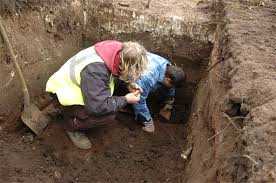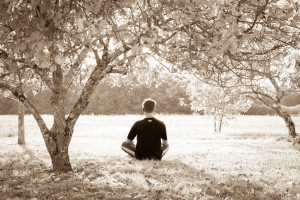Note: the video is essentially the same as the text below. Pick whichever format you like best!
 The working metaphor I use for mindfulness meditation is of an archeological dig.
The working metaphor I use for mindfulness meditation is of an archeological dig.
In archaeology, a dig starts with shovels and pick axes, with tools and processes. Eventually, this culminates in the discovery of artifacts, fossils and other treasures.
Mindfulness meditation is very similar.
We start with method and fundamentals, learning to be present-moment-aware with an equanimous and curious attitude. After this stabilizes, it culminates in “insight” into the nature of our hearts and minds.
This insight directly leads to inner freedom. The inner freedom is itself a profound resting place, but it’s also the ground that allows us to be deeply engaged with life.
 First Stage of Mindfulness Meditation
First Stage of Mindfulness Meditation
In the first stage, we learn to be aware with an equanimous and curious attitude.
On the awareness side, this means getting a taste for present moment awareness. It doesn’t really matter what we’re aware of. The tingling in the left hand. The breathing process. Vision. The flow of sounds. Even just being aware of awareness itself. All that matters is we stabilize our attention in some present moment experience.
In trying to stabilize awareness, we notice how distractions happen constantly. We notice physical discomfort, compulsive thoughts, difficult emotions or feelings. We notice how we are endlessly wanting things to be other than they are.
Here’s where attitude enters the picture.
Alongside awareness, we learn to greet all experience with an equanimous attitude. Allowing, accepting, non-reacting, being content. No matter what is happening, we learn to befriend it. To allow it to be there, whether that’s a loud sound, a chaotic mind, physical pain or intense emotions.
We just do our practice—say, maintaining awareness of sound, and allow all those “distractions” to float on through. We neither ignore them nor indulge them. We just let them do their thing, and pass on through.
Importantly, this equanimous, allowing attitude is not passive or resigned—rather, it’s engaged, interested, curious.
For example, if we notice difficult emotions, we might shift our awareness from the story lines to discover the somatic feel. If we notice chaotic thoughts, we might investigate what is motivating that thinking. If we notice physical discomfort, we might dive into the heart of the sensations and notice how they are actually constantly changing.
Most of all, we notice what’s happening, and we notice our relationship with what’s happening—are we allowing or resisting?
 Second Stage of Mindfulness Meditation
Second Stage of Mindfulness Meditation
The second stage is when insights start to happen. Really, this is just another way of saying we learn deeper principles of how our hearts and minds work.
While there are classical insights that all meditators eventually stumble upon, I like to initially keep it pretty simple.
For example, one of the first insights people usually have is just how chaotic and out-of-control their minds actually are (can you be 100% continuously aware with an equanimous attitude for, say, 10 minutes? Why not!?)
Likewise, we pretty quickly have insight into which attitudes cause pain and suffering, like self-hatred or resisting what is; and which attitudes cause wellness and joy, like accepting ourselves and being curious. This insight is the starting point for learning how to actually change an attitude.
One common form of insight happens through the mind spontaneously making connections, like noticing how feelings, thoughts, beliefs and sensations are all interlinked. We can’t just decide which thought or feeling to have next. Everything is out of our immediate control, unfolding through a deep process of cause and effect. The deeper this insight, the more we are able to relax our inner reality.
And, for the classical insight that I’ve personally found most transformative: insight into “no-self.” We notice there is a fundamental difference between awareness and the objects of awareness, like thoughts, beliefs, emotions or body sensations. The more deeply we realize the difference, the more profound our inner freedom.
I love pointing out the “early wins” for beginning meditators—they are often so focused on “getting it right” or having major life epiphanies, that they don’t realize how all their small realizations add up, and over time actually make a big difference.
Insight is the juice of mindfulness meditation—it’s a gateway to inner freedom and a life of deep engagement.
 Third Stage of Mindfulness Meditation
Third Stage of Mindfulness Meditation
Using a model of stages is actually pretty silly. This is because mindfulness meditation unfolds in a very non-linear way. It’s more about releasing into a process than striving to get somewhere.
And yet, I’m calling this stage three, because there’s a point when a meditator trusts themselves and trusts the process—they stop thinking in terms of getting insight, benefits, better awareness or attaining spiritual milestones.
I’m on a personal mission to help meditators start at stage three (radical non-linear-ness!). I’d love for everyone to see from the beginning that it’s just about relaxing into present moment awareness with an equanimous and curious attitude.
As I like to say, we never graduate from fundamentals!
